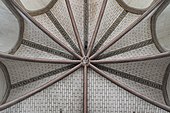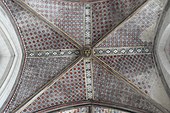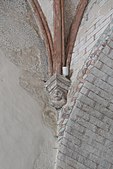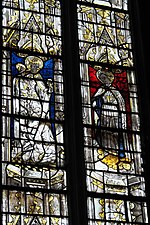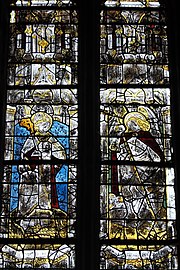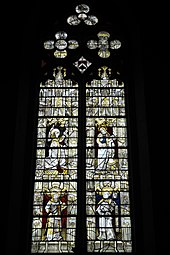St-Etienne (Eymoutiers)
The Catholic collegiate church Saint-Étienne in Eymoutiers , a parish in the Haute-Vienne department in the French region of Nouvelle-Aquitaine , was built in the 11th or 12th century on the foundations of a monastery from the Carolingian era . The church has stained glass windows from the second half of the 15th century. The church consecrated to Saint Stephen was added to the list of architectural monuments ( Base Mérimée ) in France in 1907 as Monument historique .
history
The oldest parts of the church, the foundation walls of the tower and the nave go back to the 11th century. The nave was changed in the 12th century and the transept was renewed in the second half of the 13th century. From the middle of the 15th century, the choir was completely rebuilt. At the beginning of the 16th century, two chapels were added to the transept.
architecture
Exterior construction
The 35 meter high Romanesque bell tower is attached to the west facade . Its lower floors are structured by blind arcades, while high, pointed arched sound arcades open on the bell floor . The top floor is decorated with round-arched corner turrets.
The main portal dates from the 13th century. It is built onto the south transept and is framed by arched archivolts that rest on partially sculptured consoles . Barely protruding porch is covered by narrow stone slabs on designed as heads corbels rest that go back even to the Roman church. A rose window is cut into the transept facade above the portal .
inner space
The two-bay nave also dates from the Romanesque period. It is covered by a barrel vault underpinned with belt arches . The two side chapels were added in the Gothic period. The transept, which was started in the 11th century, was continued in the 13th and 15th centuries. The choir was built from 1451. It is covered by a nine-part rib vault.
Leaded glass window
In the choir, lead glass windows that were made between 1465 and 1500 have been preserved. They represent the most extensive cycle of leaded glass windows from this period in the Limousin and are among the most beautiful windows in central France. Over 150 people are represented on them. From 1870 individual windows were restored and reassembled by the glass painter Lucien-Léopold Lobin in Tours . In the 1880s, the windows in Emmanuel Champigneulle's glass painting workshop in Bar-le-Duc were restored and partially completed. Further restorations were carried out at the beginning of the 20th century by Francis Chigot and his son Pierre and in the 1980s by the Atelier du Vitrail in Limoges .
- Central choir window (window 0)
The central choir window consists of two lancets and is divided into three levels, on which six figures of saints are depicted standing in niches under canopies. Below you can see the apostles John with a chalice in his hand and Andrew with the St. Andrew's cross , in the middle the apostle Peter with a large key and St. Stephen, who is holding the martyr's palm in his left hand and a book in his right hand the stones of his martyrdom lie. On the upper level you can see St. Joseph with a staff from which lilies grow, and a Madonna and Child. In the tracery that is Judgment represented in the top center of Christ the Judge, surrounded by Mary and John, including climbing a pope and a king from their graves. On the small disk below the scene of the resurrection of the dead you can see an angel of trumpets.
- Window 1
On the two lancets of the left choir window, six people are also depicted in niches under canopies. Below are the apostle James the Elder , on whose hat a shell is attached, and Mary Magdalene with her ointment vessel. In the middle level the apostles Paul can be seen with his sword and Philip with the cross. Above are the Bishop of Limoges Jean de Barthon I with his coat of arms and John the Baptist , who is clad in a fur and holds a book in his hand on which the Lamb of God lies. On the upper pane in the tracery you can see the crenellated walls of paradise and behind them the snake that winds around the tree trunk, below you can see Adam and Eve covering their nakedness.
- Window 2
Six apostles are depicted on the two lancets of the right choir window, each holding a book and the tools by which they suffered their martyrdom. James the Younger holds a fuller's rod, Simon a saw, Thomas a lance, Bartholomew a knife, Matthias an ax. The figure of Judas Thaddäus is incomplete. Close-up music making as well as the sun and moon are depicted in the tracery.
- Window 3
The left side choir window is divided into four levels. On the lower level, the donor couple, a knight and a lady kneeling at a prayer chair and wearing a pointed bonnet, are shown. On the level above, St. Margaret with the dragon at her feet and St. Catherine with the sword, the martyr's palm and a book in her hand are shown. Further up, on the left, the French King Louis the Saint with the crown on his head and the scepter in his hand, his blue cloak is embroidered with fleurs-de-lys , and on the right, John the Baptist, who is clothed with a fur and on the Lamb of God shows. A bishop and St. Leonhard can be seen on the upper level . The discs in the tracery show Christ on the cross and under the cross Mary and John.
- Window 4
The right side choir window is also divided into four levels. Below you can see the donors, a total of twelve people, above St.Anthony and St.Christopher . A bishop and St. Sebastian with arrows in hand can be seen on the following discs . St. Anne and a Madonna and Child are depicted on the upper level . Angels making music and Christ at rest can be seen in the tracery .
- Window 5
The window is mainly done in grisaille and silver solder . On the two lancets of the window below are St. Joseph, at whose feet a knight kneels, and St. Anthony, at whose feet the Antonius fire blazes. The upper panes show a Madonna and Child with a flower in her hand, next to it a fragment with the feet of the Archangel Michael , who is fighting against Lucifer . In the tracery, three angels with banners frame the annunciation scene.
- Window 6
On the lower panes you can see the French King Louis the Saint with the royal crown at his feet and Jacques d'Armagnac . Both of them hold banners in their hands, with five other people lined up behind them. The upper panes show a Madonna and Child with a flower in her hand and the holy Psalm, the legendary founder of Eymoutiers, who stands on an island in the sea with fish swimming in it.
- Window 7
On the lower panes you can see St. Anthony with a book, a bell and his staff in his hand, a 'T' is drawn on his chest. Above are John the Baptist and Saint Louis. In the tracery, three angels frame the face of Jesus.
- Window 8
Four saints are depicted on the double-lane window, below Saint Valeria with the martyr's palm and a hermit, perhaps Saint Anthony, above Saint Martial of Limoges , the first bishop of Limoges, and the Apostle Peter with his key.
- Window 9
The window is mainly made in grisaille technique with silver solder. The lower panes show the motif of Anna the third of herself , next to Mary Magdalene with her ointment vessel. Above you can see a bishop and the Archangel Michael with Lucifer at his feet. Angels and the Lamb of God can be seen in the tracery.
- Window 10
On the window below the martyr Valeria and the bishop Martial of Limoges can be seen, above St. Christopher next to the apostle Bartholomew, who holds a knife in his hand as his instrument of torture. The discs in the tracery contain scenes from the Last Judgment. Christ is enthroned as the judge of the world on the rainbow, trumpet angels blow to the resurrection of the dead, a Pope rises from his grave.
- Window 11
The representations of saints are marked with inscriptions. The figure on the lower level, clad in a hermelin-trimmed cloak with a raised sword, was later renamed Saint Valeria. The hermit Amand can be seen next to her, above St. Laurentius with his attribute , the grill, and the bishop Eutropius of Saintes .
- Window 12
The two saints on the lower left pane represent Mary Magdalene with her ointment vessel and presumably St. Catherine of Alexandria. On the lower right pane is St. Sebastian who is martyred by two archers. At the top left are John the Baptist and the Apostle John, at the top right the Apostle James the Elder with a scallop on his hat and a pilgrim's staff in his hand and St. Stephen with a book on which are the stones for his martyrdom. The scene of the Annunciation is depicted in the tracery, above the Holy Spirit in the form of a dove.
- Window 13
The panels depicting the Annunciation were made by Lucien-Léopold Lobin in 1872 using individual fragments from the late 15th century. Old disks were used for the face of Mary and the dove of the Holy Spirit.
- Window 14
On the two lancets of the window, Saint Stephen and the Apostle Peter are shown below, above the scene of the Annunciation. The tracery consists of two four-pass and one three-pass window. The three-pass window shows the coronation of Mary by the Trinity . In the left four-pass window you can see God the Father in the middle, who is surrounded by the symbols of the evangelists . The right quadruple window shows the crucifixion scene with Mary and John.
- Window 101
On the round window in the north transept, Christ is depicted on the cross with Mary and John. The window contains fragments such as the figures of Mary and Jesus and the clothes of John, which are dated between 1490 and 1500.
Furnishing
- The choir stalls and the eagle lectern are works from the 18th century.
- The large carved wooden crucifix in the north transept is dated to the 17th century.
- The only partially preserved saint figure in the south transept probably dates from the 16th century. She originally belonged to a crucifixion or entombment group.
literature
- Visit of the Collégiale Saint-Etienne d'Eymoutiers . Paroisse Sainte-Anne des Monts et Rivières (Ed.), Eymoutiers o.J.
- Françoise Gatouillat, Michel Hérold: Les vitraux d'Auvergne et du Limousin . (= Corpus vitrearum ). Recensement des vitraux anciens de la France, Volume IX, Presses Universitaires de Rennes, Rennes 2011, ISBN 978-2-7535-1381-5 , pp. 253-265.
- Erich Grau, Margit Kilian: The Limousin . DuMont Buchverlag, Cologne 1992, ISBN 3-7701-2732-3 , p. 267.
- Limousin . Hachette, Guides Bleus, Paris 1997, ISBN 2-01-242306-X , pp. 492-493.
Web links
- Église Saint-Étienne in the Base Mérimée of the French Ministry of Culture (French)
- La collégiale Mairie d'Eymoutiers (accessed April 25, 2018, French text)
Individual evidence
- ↑ 16 stained glass windows from the 15th century in the Base Palissy of the French Ministry of Culture (French)
- ↑ Église Saint-Étienne in the Base Mérimée of the French Ministry of Culture (French)
- ↑ Collégiale d'Augustins Saint-Etienne in the Base Mérimée of the French Ministry of Culture (French)
- ↑ Window 0 in Base Palissy of the French Ministry of Culture (French)
- ↑ Window 1 in Base Palissy of the French Ministry of Culture (French)
- ↑ Window 2 in Base Palissy of the French Ministry of Culture (French)
- ↑ Window 3 in Base Palissy of the French Ministry of Culture (French)
- ↑ Window 4 in Base Palissy of the French Ministry of Culture (French)
- ↑ Window 5 in Base Palissy of the French Ministry of Culture (French)
- ↑ Window 6 in Base Palissy of the French Ministry of Culture (French)
- ↑ Window 7 in Base Palissy of the French Ministry of Culture (French)
- ^ Window 8 in Base Palissy of the French Ministry of Culture (French)
- ↑ Window 9 in the Base Palissy of the French Ministry of Culture (French)
- ↑ Window 10 in Base Palissy of the French Ministry of Culture (French)
- ↑ Window 11 in Base Palissy of the French Ministry of Culture (French)
- ↑ Window 12 in Base Palissy of the French Ministry of Culture (French)
- ↑ Window 13 in Base Palissy of the French Ministry of Culture (French)
- ↑ Window 14 in Base Palissy of the French Ministry of Culture (French)
- ↑ Window 101 in the Base Palissy of the French Ministry of Culture (French)
- ↑ Adler's desk in the Base Palissy of the French Ministry of Culture (French)
- ↑ Crucifix in the Base Palissy of the French Ministry of Culture (French)
- ↑ Figure of a saint in Base Palissy of the French Ministry of Culture (French)
Coordinates: 45 ° 44 ′ 20 " N , 1 ° 44 ′ 39.8" E




